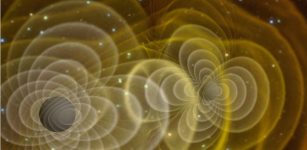Dark Matter Exists: Doubts On Its Presence In Galaxies Have Been Disproved
Eddie Gonzales Jr. – MessageToEagle.com – New research conducted by SISSA scientists clarifies one of the recent most intriguing controversies on dark matter.
As fascinating as it is mysterious, dark matter is one of the greatest enigmas of astrophysics and cosmology.
 Acceleration as a function of radius in NGC 4455, one of the studied galaxies. Credits: Di Paolo et al. modified from survey SDSS9.
Acceleration as a function of radius in NGC 4455, one of the studied galaxies. Credits: Di Paolo et al. modified from survey SDSS9.
It is the most widespread form of matter in the Universe, which does not emit any type of electromagnetic radiation, and describes its relationship with ordinary matter.
It is thought to account for 90% of the matter in the Universe, but its existence has been demonstrated only indirectly and recently called into question.
New research conducted by SISSA removes the recent doubts on the presence of dark matter within the galaxies.
The study also offers new insights into understanding the nature of dark matter and its relationship with ordinary matter.
From the expansion of the universe to the movement of stars in the galaxies, the phenomena are many, which, the presence of ordinary matter alone, namely that composed by atoms, is unable to explain. The attractive force it generates is not sufficient. This had led to the theory of the existence of dark matter, namely undetectable, and the idea that galaxies are embedded in its spherical halo.
 Dark matter is one of the greatest enigmas of astrophysics and cosmology.
Dark matter is one of the greatest enigmas of astrophysics and cosmology.
“Three years ago, a few colleagues of the Case Western Reserve University strongly questioned our understanding of the universe and the in-depth work of many researchers, casting doubt on the existence of dark matter in the galaxies,” Chiara Di Paolo, a doctoral student of astrophysics at SISSA, says in a press release.
“Analysing the rotation curves of 153 galaxies, principally the ‘classical’ spiral kind, they obtained an empirical relationship between total gravitational acceleration of the stars (observed) and the component which we would observe in the presence of sole ordinary matter in the classical Newtonian theory. This empirical relationship which seemed valid in all the galaxies they analyzed and at any galactic radius, motivated the explanation of gravitational acceleration without necessarily calling into question dark matter, but involving for example theories of modified gravity such as MOND (Modified Newtonian Dynamics).”
Di Paolo and her collaborators wanted to verify this relationship, analysing the rotation curves of galaxies other than the “classical” spiral kind: 72 galaxies with low surface brightness (LSB) and 34 dwarf disc galaxies. They produced more extended results, finding a relationship, which, besides total gravitational acceleration and its ordinary component, also involves the galactic radius and the morphology of the galaxies.
“We have studied the relationship between total acceleration and its ordinary component in 106 galaxies, obtaining different results from those that had been previously observed,” explains Paolo Salucci, professor of astrophysics at SISSA and one of the research authors.
“This not only demonstrates the inexactness of the empirical relationship previously described but removes doubts on the existence of dark matter in the galaxies. Furthermore, the new relationship found could provide crucial information on the understanding of the nature of this indefinite component.”
Written by Eddie Gonzales Jr. – MessageToEagle.com Staff Writer










